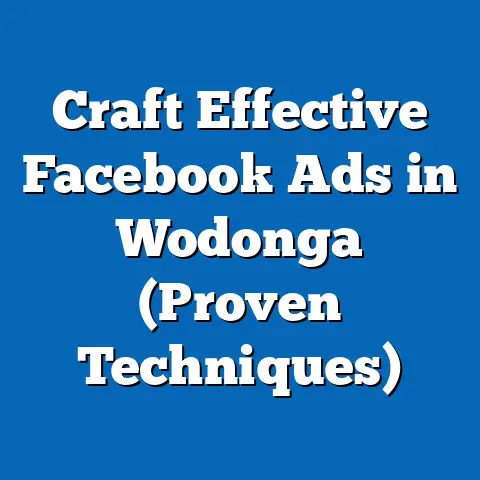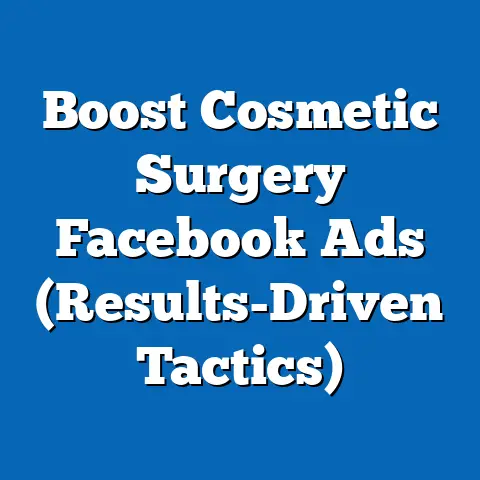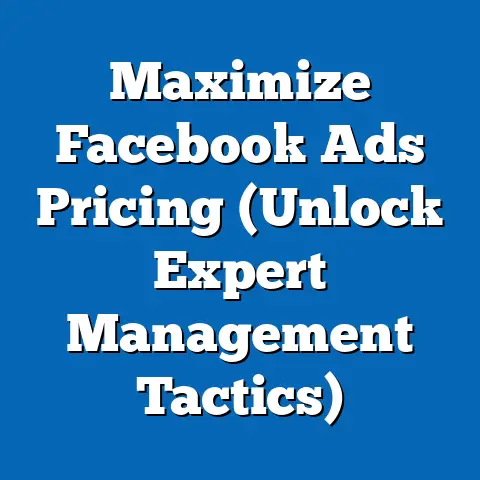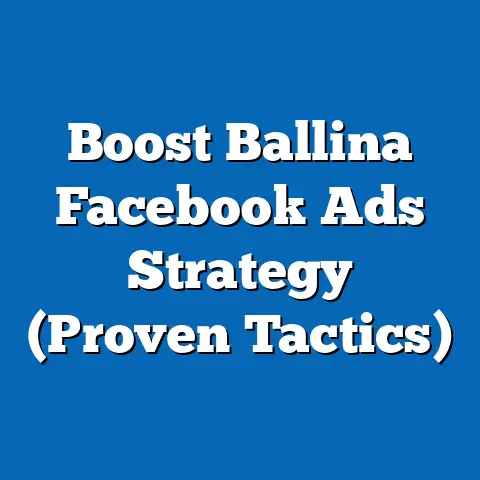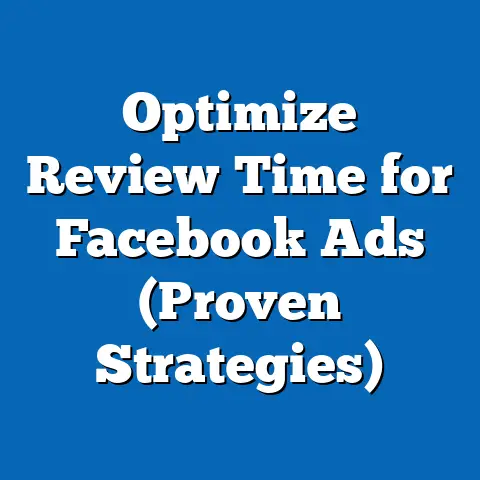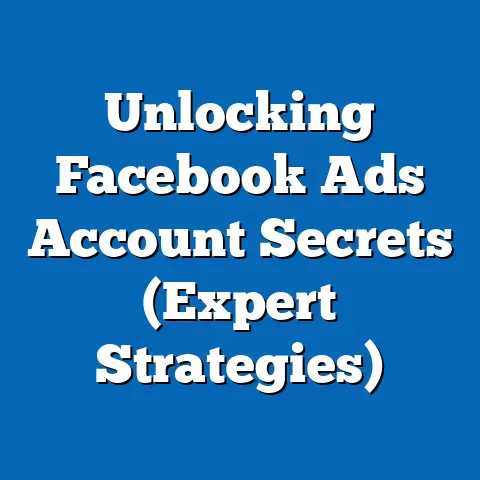End Facebook Ad Campaign (Essential Recovery Strategies)
Facebook advertising can be a powerful tool for businesses of all sizes. I’ve seen firsthand how a well-crafted campaign can drive incredible results, from boosting brand awareness to generating leads and driving sales. However, not every campaign is a roaring success from the start. Sometimes, despite our best efforts, campaigns plateau or even decline. Knowing when to pull the plug and, more importantly, what to do next, is just as crucial as launching the campaign in the first place.
In this article, I’ll dive deep into the world of Facebook ad campaigns, focusing specifically on the often-overlooked aspect of ending a campaign and the essential recovery strategies you should implement afterward. We’ll explore how to recognize the signs that a campaign is no longer performing, the importance of post-campaign data analysis, and, most importantly, how to craft a robust recovery strategy to re-engage your audience and leverage your learnings for future success.
Why Accessibility Matters in Facebook Advertising
Before we dive into the specifics of ending campaigns, let’s talk about accessibility. Accessibility, in the context of digital marketing, refers to designing and creating content that is usable by people of all abilities. This includes people with visual, auditory, motor, cognitive, and speech impairments.
Why is this important? Well, for several reasons:
- It’s the right thing to do: Inclusivity should be a core value of any business. Making your ads accessible ensures that you’re not excluding a significant portion of the population.
- It expands your reach: People with disabilities represent a substantial market segment. By creating accessible ads, you open yourself up to a wider audience.
- It improves engagement: Accessible ads often benefit everyone, not just people with disabilities. For example, clear and concise ad copy, which is essential for people with cognitive impairments, also makes your ads more effective for everyone.
- It can boost your ROI: Studies have shown that businesses that prioritize accessibility often see increased engagement and conversion rates.
According to a recent report by the World Health Organization, over 1 billion people worldwide live with some form of disability. That’s a significant portion of the global population that you could be missing out on if your ads aren’t accessible.
Accessibility in Facebook advertising can take many forms, including:
- Adding alt text to images: Alt text provides a textual description of an image, which is essential for people who are blind or visually impaired.
- Using captions and transcripts for videos: Captions and transcripts make your video content accessible to people who are deaf or hard of hearing.
- Ensuring sufficient color contrast: Adequate color contrast makes your text easier to read for people with low vision or color blindness.
- Writing clear and concise ad copy: Simple and easy-to-understand language benefits everyone, especially people with cognitive impairments.
- Using accessible ad formats: Some ad formats, like carousel ads, can be more accessible than others, depending on how they’re implemented.
By prioritizing accessibility in your Facebook advertising, you can create more inclusive, engaging, and effective campaigns that reach a wider audience and drive better results.
Takeaway: Accessibility is not just a nice-to-have; it’s a must-have for modern Facebook advertising. It’s the right thing to do, it expands your reach, it improves engagement, and it can boost your ROI.
Understanding When to End a Facebook Ad Campaign
Knowing when to end a Facebook ad campaign is crucial for maximizing your return on investment (ROI) and preventing wasted ad spend. It’s a skill I’ve honed over years of managing numerous campaigns. It involves closely monitoring key performance indicators (KPIs), recognizing patterns, and making data-driven decisions.
Key Indicators That Signal It’s Time to Pull the Plug
Here are some key indicators that suggest it might be time to end a Facebook ad campaign:
- Decreasing Click-Through Rate (CTR): A declining CTR indicates that your ad is no longer resonating with your target audience. People are seeing your ad, but they’re not clicking on it. This could be due to ad fatigue, irrelevant targeting, or unengaging ad creative.
- Increasing Cost Per Acquisition (CPA): A rising CPA means you’re paying more to acquire a customer or lead. This could be due to increased competition, changes in the Facebook algorithm, or a decline in the quality of your landing page.
- Decreasing Return on Ad Spend (ROAS): A falling ROAS signals that your ad campaign is becoming less profitable. You’re spending more on ads than you’re generating in revenue. This is a clear sign that something needs to change.
- Audience Fatigue: If you’re targeting the same audience for an extended period, they may become tired of seeing your ads. This can lead to decreased engagement and higher costs.
- Irrelevant or Low-Quality Leads: If your ad campaign is generating leads, but those leads are not qualified or relevant to your business, it’s a sign that your targeting is off or your ad copy is misleading.
- Changes in the Market: Sometimes, external factors, such as changes in the market, new competitors, or shifts in consumer behavior, can render your ad campaign ineffective.
- Poor Ad Relevance Score: Facebook assigns a relevance score to your ads based on how well they resonate with your target audience. A low relevance score indicates that your ad is not relevant or engaging, which can lead to higher costs and lower performance.
Consequences of Not Ending a Campaign When Necessary
Failing to end a campaign when the indicators are flashing red can have several negative consequences:
- Wasted Budget: Continuing to run a poorly performing campaign means you’re throwing money away on ads that aren’t generating results.
- Diminishing Returns: As your campaign continues to underperform, you’ll likely see a decline in engagement, conversions, and ROI.
- Brand Damage: Running irrelevant or annoying ads can damage your brand reputation and alienate potential customers.
- Missed Opportunities: By clinging to a failing campaign, you’re missing out on opportunities to invest your budget in more effective strategies.
Real-Life Examples of Timely Campaign Termination
Let me share a personal anecdote to illustrate this point. I once worked with an e-commerce client who was running a Facebook ad campaign to promote a new line of winter clothing. Initially, the campaign performed well, generating a strong ROAS. However, as winter drew to a close, the campaign’s performance began to decline. The CTR decreased, the CPA increased, and the ROAS plummeted.
Despite the warning signs, the client was hesitant to end the campaign. They argued that they had already invested a significant amount of time and money into it and didn’t want to “give up” just yet. I advised them to cut their losses and reallocate their budget to a new campaign promoting their spring collection.
Reluctantly, they agreed. Within a week of launching the new campaign, their sales rebounded, and their ROAS returned to its previous high. This experience taught me the importance of being objective and data-driven when making decisions about ad campaigns. Sometimes, the best course of action is to cut your losses and move on.
Takeaway: Regularly monitor your Facebook ad campaigns and be prepared to end them when the KPIs indicate that they’re no longer performing effectively. Don’t let emotions or sunk costs cloud your judgment.
The Importance of Data Analysis Post-Campaign
Ending a Facebook ad campaign is just the first step. The real value lies in the data you collect and analyze after the campaign has ended. This post-campaign analysis is crucial for understanding what worked, what didn’t, and how to improve your future campaigns. It’s like conducting an autopsy; you’re examining the remains to understand the cause of death and prevent similar occurrences in the future.
Conducting a Thorough Analysis of Ad Performance
Here’s how to conduct a thorough analysis of your ad performance after a campaign ends:
- Gather All Relevant Data: Collect all the data related to your campaign, including impressions, clicks, CTR, CPA, ROAS, conversions, demographics, and placements.
- Identify Key Performance Indicators (KPIs): Focus on the KPIs that are most relevant to your business goals. For example, if your goal was to generate leads, focus on the cost per lead (CPL) and the lead quality. If your goal was to drive sales, focus on the ROAS and the conversion rate.
- Segment Your Data: Segment your data by demographics, placements, interests, and other relevant factors to identify patterns and trends. For example, you might find that your ads performed better with a specific age group or on a particular placement.
- Compare Your Results to Your Benchmarks: Compare your campaign’s performance to your historical benchmarks and industry averages. This will help you understand how well your campaign performed relative to your expectations and your competitors.
- Identify What Worked and What Didn’t: Based on your analysis, identify the elements of your campaign that worked well and the elements that didn’t. This could include your ad creative, your targeting, your bidding strategy, or your landing page.
- Document Your Findings: Document your findings in a clear and concise report. This report should include a summary of your campaign’s performance, a list of what worked and what didn’t, and recommendations for future campaigns.
Tools and Resources for Analyzing Facebook Ad Performance
Facebook provides several tools and resources for analyzing your ad performance:
- Facebook Ads Manager: The Ads Manager is your primary tool for managing and analyzing your Facebook ad campaigns. It provides a wealth of data and insights, including detailed reports on impressions, clicks, CTR, CPA, ROAS, and conversions.
- Facebook Analytics: Facebook Analytics allows you to track user behavior on your website and app, providing valuable insights into how your ads are driving traffic and conversions.
- Google Analytics: Google Analytics is a powerful web analytics tool that can help you track the performance of your Facebook ad campaigns and understand how they’re contributing to your overall website traffic and conversions.
- Third-Party Analytics Tools: Several third-party analytics tools, such as SEMrush and Ahrefs, can provide additional insights into your Facebook ad performance and help you track your competitors.
How Data Analysis Informs Future Campaigns
The insights you gain from post-campaign data analysis can be invaluable for informing your future campaigns. By understanding what worked and what didn’t, you can make data-driven decisions about your ad creative, targeting, bidding strategy, and landing page.
For example, if you find that your ads performed better with a specific age group, you can focus your targeting on that age group in your future campaigns. If you find that a particular ad creative generated a high CTR, you can use that creative as a template for your future ads. If you find that your landing page had a low conversion rate, you can optimize it to improve its performance.
Takeaway: Post-campaign data analysis is essential for understanding what worked and what didn’t in your Facebook ad campaigns. Use the insights you gain to inform your future campaigns and improve your ROI.
Crafting a Recovery Strategy
So, you’ve ended your Facebook ad campaign, analyzed the data, and identified the areas that need improvement. Now it’s time to craft a recovery strategy. A recovery strategy is a plan for re-engaging your audience and leveraging your learnings to create more effective campaigns in the future. It’s about turning a setback into an opportunity for growth.
A Step-by-Step Guide to Creating a Recovery Strategy
Here’s a step-by-step guide to creating a recovery strategy after ending a Facebook ad campaign:
Step 1: Gather All Relevant Data and Insights from the Campaign
As we discussed earlier, data analysis is crucial for understanding what worked and what didn’t in your campaign. Gather all the relevant data and insights, including:
- Campaign Performance Metrics: Impressions, clicks, CTR, CPA, ROAS, conversions, etc.
- Audience Demographics: Age, gender, location, interests, etc.
- Placement Performance: Where your ads were shown (e.g., Facebook News Feed, Instagram Stories)
- Ad Creative Performance: Which ad creatives generated the most engagement and conversions
- Landing Page Performance: Conversion rate, bounce rate, time on page, etc.
Step 2: Identify Target Audience Segments That Showed Promise
Not all audience segments are created equal. Some segments may have responded better to your ads than others. Identify the segments that showed the most promise, based on their engagement, conversion rate, and ROAS.
For example, you might find that your ads performed particularly well with women aged 25-34 who are interested in fitness. This segment could be a valuable target audience for your future campaigns.
Step 3: Develop Hypotheses on What Could Be Improved in Future Campaigns
Based on your data analysis, develop hypotheses on what could be improved in your future campaigns. This could include:
- Ad Creative: Could you create more engaging or relevant ad creatives?
- Targeting: Could you refine your targeting to reach a more qualified audience?
- Bidding Strategy: Could you optimize your bidding strategy to lower your CPA?
- Landing Page: Could you improve your landing page to increase your conversion rate?
- Ad Placement: Are there certain ad placements that perform better than others?
Step 4: Create a Re-Engagement Plan to Reconnect With the Audience
A re-engagement plan is a strategy for reconnecting with the audience that you targeted in your previous campaign. This could include:
- Retargeting Ads: Showing ads to people who have previously interacted with your website or Facebook page.
- Email Marketing: Sending emails to your existing email list to promote your products or services.
- Content Marketing: Creating valuable content that attracts and engages your target audience.
- Social Media Engagement: Interacting with your followers on social media and building relationships.
Actionable Tips for Each Step
Here are some actionable tips for each step of the recovery strategy:
- Gather All Relevant Data and Insights: Use Facebook Ads Manager and Google Analytics to collect comprehensive data on your campaign’s performance.
- Identify Target Audience Segments That Showed Promise: Use Facebook Audience Insights to analyze the demographics and interests of your target audience.
- Develop Hypotheses on What Could Be Improved: Use A/B testing to test different ad creatives, targeting options, and landing pages.
- Create a Re-Engagement Plan: Use Facebook Custom Audiences to target people who have previously interacted with your website or Facebook page.
Takeaway: A well-crafted recovery strategy is essential for turning a setback into an opportunity for growth. By gathering data, identifying promising audience segments, developing hypotheses, and creating a re-engagement plan, you can improve your future campaigns and achieve your business goals.
Re-Engaging Your Audience
Once you’ve crafted your recovery strategy, the next step is to re-engage your audience. This involves reconnecting with the people who were targeted in your previous campaign and reminding them of your brand, products, or services. It’s like rekindling a flame that has started to die down.
Strategies for Re-Engaging Your Audience
Here are some effective strategies for re-engaging your audience after a campaign has ended:
- Retargeting Ads: Retargeting ads are a powerful way to re-engage your audience. They allow you to show ads to people who have previously interacted with your website, Facebook page, or other online properties. For example, you can show ads to people who have visited your website but didn’t make a purchase, or to people who have liked your Facebook page but haven’t engaged with your content recently.
- Email Marketing: Email marketing is another effective way to re-engage your audience. You can send emails to your existing email list to promote your products or services, share valuable content, or offer exclusive discounts.
- Content Marketing: Content marketing involves creating valuable content that attracts and engages your target audience. This could include blog posts, articles, videos, infographics, or social media posts. By creating high-quality content, you can build relationships with your audience and establish yourself as a thought leader in your industry.
- Social Media Engagement: Social media engagement involves interacting with your followers on social media and building relationships. This could include responding to comments, answering questions, sharing valuable content, or running contests and giveaways.
The Role of Personalized Messaging and Segmentation
Personalized messaging and segmentation are crucial for effective re-engagement. Generic messages that are sent to everyone are unlikely to resonate with your audience. Instead, you should tailor your messages to the specific interests and needs of each segment.
For example, if you’re retargeting people who have visited your website but didn’t make a purchase, you could show them ads that feature the specific products they were viewing. If you’re sending emails to your email list, you could segment your list by demographics, interests, or purchase history and send personalized messages to each segment.
Successful Case Studies of Brands That Effectively Re-Engaged Their Audiences
Let me share a few examples of brands that have successfully re-engaged their audiences after a campaign has ended:
- Dollar Shave Club: Dollar Shave Club is a subscription service that delivers razors and grooming products to its customers. They use retargeting ads to re-engage people who have visited their website but didn’t subscribe. Their retargeting ads often feature humorous videos that highlight the benefits of their service.
- HubSpot: HubSpot is a marketing automation platform that helps businesses attract, engage, and delight their customers. They use email marketing to re-engage their existing customers and prospects. Their emails often feature valuable content, such as blog posts, ebooks, and webinars.
- Nike: Nike is a global sportswear brand that uses social media engagement to connect with its followers. They often run contests and giveaways on social media to encourage engagement and build relationships.
Takeaway: Re-engaging your audience is crucial for maximizing your ROI and building long-term relationships with your customers. Use retargeting ads, email marketing, content marketing, and social media engagement to reconnect with your audience and remind them of your brand.
Leveraging Learnings for Future Campaigns
The ultimate goal of ending a Facebook ad campaign and implementing a recovery strategy is to learn from your mistakes and improve your future campaigns. It’s about turning a negative experience into a positive one by extracting valuable insights and applying them to your future advertising efforts.
Applying Insights Gained from the Terminated Campaign
Here are some ways to apply the insights you gained from the terminated campaign to your future advertising efforts:
- Refine Your Targeting: Use the data you collected to refine your targeting and reach a more qualified audience.
- Improve Your Ad Creative: Use the insights you gained to create more engaging and relevant ad creatives.
- Optimize Your Bidding Strategy: Use the data you collected to optimize your bidding strategy and lower your CPA.
- Improve Your Landing Page: Use the insights you gained to improve your landing page and increase your conversion rate.
- Test Different Ad Placements: Experiment with different ad placements to see which ones perform best for your business.
Documenting Lessons Learned and Creating a Knowledge Base
Documenting your lessons learned and creating a knowledge base is crucial for ensuring that your team can learn from your past experiences and avoid making the same mistakes in the future. Your knowledge base should include:
- A Summary of Your Campaign’s Performance: A brief overview of your campaign’s goals, strategies, and results.
- A List of What Worked and What Didn’t: A detailed analysis of the elements of your campaign that worked well and the elements that didn’t.
- Recommendations for Future Campaigns: Specific recommendations on how to improve your future campaigns based on your learnings.
The Value of Continuous Improvement and Staying Updated
The world of Facebook advertising is constantly evolving. New features are released, algorithms change, and consumer behavior shifts. To stay ahead of the curve, it’s essential to embrace continuous improvement and stay updated with the latest trends and best practices.
Here are some ways to stay updated with the latest in Facebook advertising:
- Follow Industry Blogs and Publications: Subscribe to industry blogs and publications that cover Facebook advertising.
- Attend Webinars and Conferences: Attend webinars and conferences to learn from industry experts.
- Join Online Communities: Join online communities and forums where marketers share their experiences and insights.
- Experiment and Test New Features: Don’t be afraid to experiment with new features and test different strategies.
Takeaway: Leveraging learnings from terminated campaigns is crucial for continuous improvement. Document your lessons learned, create a knowledge base, and stay updated with the latest trends to maximize your ROI and achieve your business goals.
Best Practices for Future Facebook Ad Campaigns
To avoid the need for frequent campaign terminations and recovery strategies, it’s essential to follow best practices when planning and executing your Facebook ad campaigns. These best practices can help you create more effective, engaging, and profitable campaigns from the start.
Key Best Practices to Follow
Here are some key best practices that marketers should follow when planning new Facebook ad campaigns:
- Define Your Goals: Clearly define your goals for each campaign. What do you want to achieve? Do you want to increase brand awareness, generate leads, drive sales, or something else?
- Research Your Audience: Thoroughly research your target audience. Who are they? What are their interests, needs, and pain points?
- Create Engaging Ad Creative: Create ad creatives that are visually appealing, relevant, and engaging. Use high-quality images and videos, and write compelling ad copy.
- Use Precise Targeting: Use precise targeting options to reach the right audience. Target people based on their demographics, interests, behaviors, and connections.
- Optimize Your Bidding Strategy: Optimize your bidding strategy to lower your CPA and maximize your ROI. Experiment with different bidding options, such as automatic bidding, manual bidding, and cost per result bidding.
- Improve Your Landing Page: Ensure that your landing page is relevant to your ad copy and easy to navigate. Optimize your landing page to increase your conversion rate.
- Monitor Your Results: Regularly monitor your campaign’s performance and make adjustments as needed. Track your KPIs, such as impressions, clicks, CTR, CPA, and ROAS.
- Test, Test, Test: Continuously test different ad creatives, targeting options, and bidding strategies to see what works best for your business.
The Significance of A/B Testing, Audience Research, and Budgeting
A/B testing, audience research, and budgeting are three critical components of successful Facebook ad campaigns:
- A/B Testing: A/B testing involves testing two or more versions of your ad creative, targeting, or landing page to see which one performs best. This allows you to identify the most effective elements of your campaign and optimize your results.
- Audience Research: Audience research involves gathering data about your target audience to understand their interests, needs, and pain points. This information can help you create more relevant and engaging ad creatives and improve your targeting.
- Budgeting: Budgeting involves setting a realistic budget for your campaign and allocating your resources effectively. This ensures that you’re spending your money wisely and maximizing your ROI.
Maintaining Accessibility Throughout the Campaign Lifecycle
As we discussed earlier, accessibility is crucial for reaching a wider audience and improving engagement. Here are some tips on maintaining accessibility throughout the campaign lifecycle:
- Add Alt Text to Images: Add alt text to all images in your ads to make them accessible to people who are blind or visually impaired.
- Use Captions and Transcripts for Videos: Use captions and transcripts for all videos in your ads to make them accessible to people who are deaf or hard of hearing.
- Ensure Sufficient Color Contrast: Ensure that there is sufficient color contrast between your text and background to make your ads easier to read for people with low vision or color blindness.
- Write Clear and Concise Ad Copy: Write clear and concise ad copy that is easy to understand for people with cognitive impairments.
- Use Accessible Ad Formats: Use accessible ad formats, such as carousel ads, that are designed to be user-friendly for people with disabilities.
Takeaway: By following best practices, such as defining your goals, researching your audience, creating engaging ad creative, and using precise targeting, you can create more effective, engaging, and profitable Facebook ad campaigns from the start.
Conclusion
Ending a Facebook ad campaign is never the ideal scenario, but it’s a necessary part of the advertising process. It’s crucial to recognize the signs that a campaign is no longer performing, analyze the data, craft a recovery strategy, re-engage your audience, and leverage your learnings for future campaigns.
Remember, campaign termination is not a failure. Instead, it’s an opportunity for growth and improvement. By embracing a data-driven approach and continuously learning from your experiences, you can create more effective, engaging, and profitable Facebook ad campaigns that achieve your business goals.
I encourage you to implement the strategies discussed in this article and share your experiences in the comments or on social media. Let’s learn from each other and create a community of successful Facebook advertisers!

